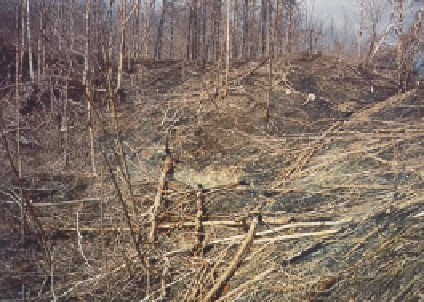Geology Reference
In-Depth Information
7.1. Environmental and Health
Impacts of Coal Fires
Robert B. Finkelman
Glenn B. Stracher
Sulfur littering this hillside at the Centralia
mine fire reacts with rain and snowmelt to
form sulfuric acid that pollutes the hydro-
logic system.
Photo by Glenn B. Stracher, 1991.
Introduction
P
ollutants released from burning coal beds and waste piles are a potential environmental and human-health hazard.
On a global scale, large volumes of greenhouse and toxic gases released from burning-coal beds and waste piles
may contribute to climate change, alter ecosystems, and affect patterns of disease occurrence. On regional and
local scales, the emissions from burning coal beds and waste piles of acidic gases, particulates, organic compounds,
and trace elements may contribute to environmental degradation and a range of respiratory and other human-health
problems. Although there are few published reports about health problems caused by these emissions, the potential
for such problems is significant. In India, large numbers of people were displaced from their homes because of
health problems associated with burning coal beds (Bharat Coking Coal Limited, 2003; Sierra Club, 2003; Stracher
and Taylor, 2004). Volatile elements such as arsenic, fluorine, mercury, and selenium are commonly enriched in
coal (Table 7.1.1). As the coal burns, these elements may volatilize and eventually be adsorbed on or by food crops,
condense on dust particles that are inhaled and ingested by humans and livestock, and bio-accumulated in birds,
fish, and other animals (Keefer and Sajwan, 1993). In addition, selenium, arsenic, lead, tin, bismuth, fluorine, and
other toxic elements are incorporated into compounds that nucleate where hot-gaseous emissions mix with the
ambient air, forming mats of concentrated efflorescent minerals on the surface of the ground (Figure 7.1.1; Figure
14 in Lapham et al., 1980). Toxic elements in these mats leached by rainwater may enter the hydrologic system,
opening the possibility to other routes of exposure or ingestion by biota. Although there is little available data
linking burning-coal beds and waste piles with human-health problems, an example of what can happen exists in
rural China, where mineralized-coal burned in residential environments has caused widespread and severe health
problems including fluorosis (fluorine poisoning, Figure 7.1.2) and arsenosis (hyperkeratosis or arsenic poison-
ing, Figure 7.1.3).
Table 7.1.1
Concentrations (parts per million) of the volatile elements arsenic, fluorine, mercury, and selenium in the
earth
s crust and in US coal.
'
Crustal average
*
US coal average
†
whole coal basis
US Coal average ash basis
‡
Element
Arsenic
1.8
24
183
Fluorine
625
98
748
Mercury
0.08
0.17
1.3
Selenium
0.05
2.9
21.4
*
Mason (1966).
†
Orem and Finkelman (2003).
‡
Based on an ash yield of 13.1 wt% and assuming no volatilization.










